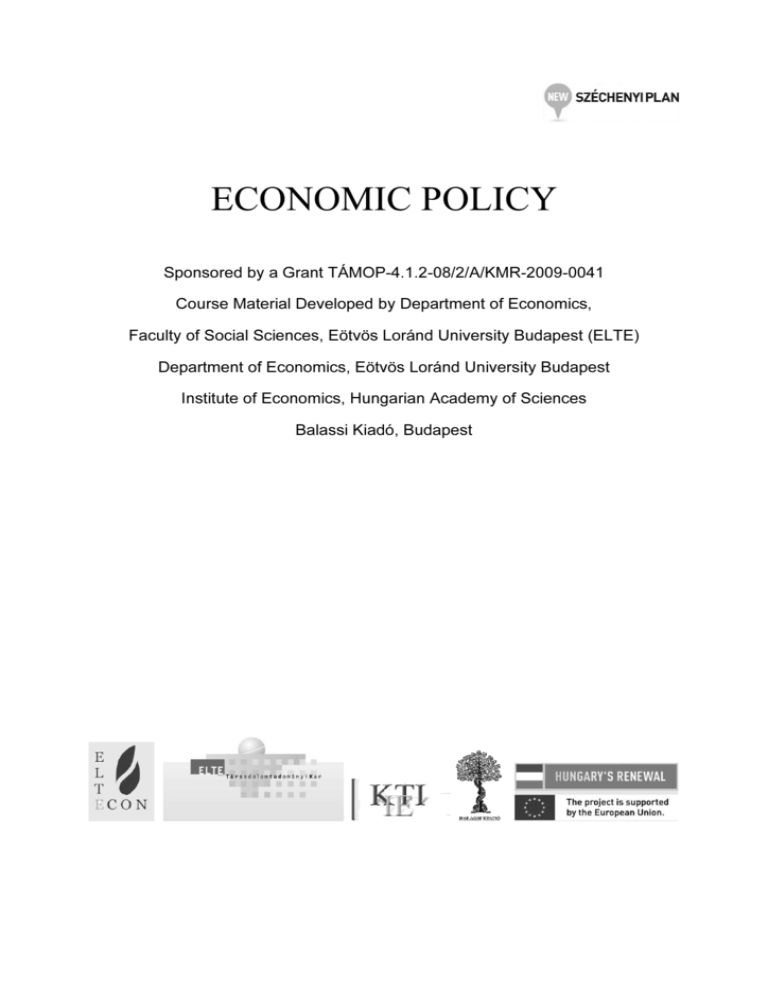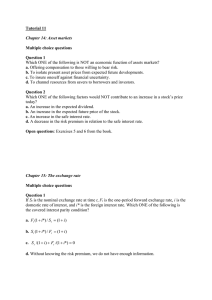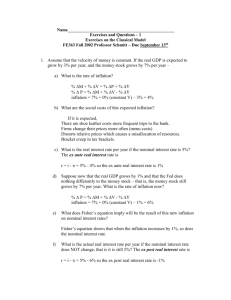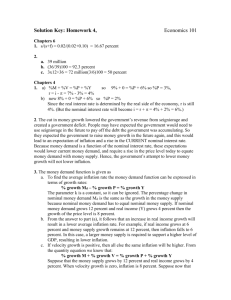ECONOMIC POLICY
advertisement

ECONOMIC POLICY Sponsored by a Grant TÁMOP-4.1.2-08/2/A/KMR-2009-0041 Course Material Developed by Department of Economics, Faculty of Social Sciences, Eötvös Loránd University Budapest (ELTE) Department of Economics, Eötvös Loránd University Budapest Institute of Economics, Hungarian Academy of Sciences Balassi Kiadó, Budapest Author: Péter Pete Supervised by Péter Pete June 2011 Week 2 Rigid price Keynesian models Money, inflation seigniorage (Old) Keynesian model • Demand for goods: • Y = D(Y, r, T) + G IS curve • Formally similar to the RBC model but • static, there is no future • aggregate ”behavior”, not based in micro • Supply of goods • No supply behavior in the model, supply passively adjusts to demand in the short run. • Money market equilibrium • M/P = L(Y, r) LM curve 2 • Long run, flexible prices, Y = Y* • Output at potential level • Potential output – nature rate of unemployment • Short run, P is constant, due to rigid prices output deviates from potential • Output gap, positive or negative Economic policy • Monetary policy (M→r→I→Y) and fiscal policy can be applied (G,T→Y) to manipulate demand, • stabilizing output, eliminating output gaps. • If prices were completely flexible, stabilization would not be needed, even in a Keynesian framework • Creating demand against recession 3 Model features • Potential output is not explained • Static, therefore inflation is also not explained • No micro behavior • Expectations are exogenous • It gives significant role for counter-cyclical policy and for unemployment • Lucas critique AA-DD model (Krugman–Obsfeld) • An open economy Keynesian macro model • Y = D(Y, T, eP*/P) DD curve • R = R* + (ee - e )/e • M/P = L(Y, R) • Substitute for R in the second two equations and solve for e • e = f(…M, P, Y , ee …) AA curve Economic policy • A new transmission mechanism in the market for goods: the real exchange rate • Long run: Y is constant at the potential level. • Short run: P is constant, we have an output gap →stabilization policy 4 • We have further economic policy goals and tools, for example: external balance (CA) and currency devaluation. AA-DD model Flexible prices • Under flexible prices money is neutral, there are no real effects • where is inflation expected for the next period • Y and r are given, M influences P and П only • From the welfare point of view nominal variables are irrelevant, there can be any price level or rate of inflation, but it does not count. 5 Monetary policy? • Can there be still any role of monetary policy? • Earning fiscal income, seigniorage • Seigniorage: government revenue derived from the monopoly of issuing money • Money is a way of holding wealth (savings) that does not bear interest. Private sector savings in this form allow the issuer to borrow for free. Seigniorage: a rent from a monopoly • Banks also create money, but they operate in a competitive market. Rent earned on that form of money is competed away. • More competition is, less rent is earned by the banks. • In traditional macroeconomic models the banking sector (financial intermediation) is assumed away. Money is the monetary base. Seigniorage • Supply of money = monetary base M • Seigniorage: the real value of the increment of the nominal money supply • where σt is the rate of growth of the money supply 6 • S = growth rate of M X real money supply • Seigniorage is created if M grows • M grows if: 1. the economy grows (Y), therefore demand for real money increases 2. P increases, there is inflation. The quantity of real money is constant, still M has to grow to hold it that way. This is inflation tax. • r does not have a trend, therefore it does not count in the short run. • In this model we concentrate on the inflation tax only. Relevance 1. High inflation. Hyperinflation is mostly the result of fiscal pressures for earning seigniorage. 2. Providing ”cheap” financing for the government budget. 3. ”Inflating away” high government debt, as an alternative for default. • Careful: „inflating away” can mean very different things. 1. Freezing expenditure items in the budget in nominal terms. Inflation will erode their real value. This is not seigniorage 2. If government debt is in bonds with fixed interest rates in nominal terms, their value is also eroded by unexpected inflation. This is not seigniorage either. 7 Realization of seigniorage • There is no line among budget receivables called seigniorage • This type of revenue is realized in the Central Bank Empirical and measurement problems Steady state seigniorage • How large seigniorage is in the long run? • In steady state σ is a constant and σ = П holds. • Maximum seigniorage 8 • Steady state seigniorage is at maximum where elasticity of the money demand function with respect to the inflation rate is unity. Maximum seigniorage Dynamics • We pull the effects coming from Y and r into a C constant. Take logs and choose units so that logC = 0. γ is elasticity of money demand with respect to inflation • where 9 • Rearranging: • Present price level is a weighted average of present money supply and the expected future price level. • An increase in m in the present increases the price level and so does an expected increase in the future price level. • Solving forward: 1 Pt = 1+ γ γ ∑ i =0 1 + γ ∞ i mt +i • The price level is a weighted average of present and future money supplies. • The weights are functions of γ, their sum is 1. • If m is a constant • The price level is the same as the money supply (c = 1). • If m increases, and it is expected to stay at the new level forever, then P increaes proportionally • Expected increases of the money supply in the future influence the current price level. 10 Example • The money supply increases in t+k Inflation • Present inflation is the weighted average of present money growth and expected future inflation. • Solving forward 1 πt = 1+ γ γ ∑ i =0 1 + γ ∞ i σ t +i • Present inflation is the weighted average of present and future money growth. 11 Conclusions • Due to forward looking expectations, any rate of inflation in the present can be a result of very different paths of money growth. • Even if present monetary growth is high, inflation can be low and decreasing, if money growth is expected to be slow in the future. • Contrary to the Monetarist theory, inflation depends not only on current money supply. Expected and unexpected increase in the growth rate of money 12 Literature • Mankiw: Macroeconomics, any edition. Chapters covering aggregate demand and aggregate supply. • Görömbey–Pete (1998): Makromodellek, egyetemi jegyzet, Debrecen • Sargent (1992): Rational expectations and inflation, Chapter 3. Pearson 1992. 13








